The Benefits of Partial vs. Total Knee Replacement
One of the most frequent questions we are asked at the Leone Center for Orthopedic Care is, “What are the benefits of a partial versus a total knee replacement?”
To answer that question, we first must explore the reasons why a particular patient may develop knee joint degeneration. At the Leone Center for Orthopedic Care, we see patients with complex knee problems of all types with joint and bone destruction including past trauma, bad outcomes from prior surgery, infection, rheumatoid or other inflammatory arthritis, or childhood diseases. Many patients have had prior open surgeries and arthroscopy. Many patients have a strong family history for knee arthritis and deformity. And indeed, many patients present with significant angular deformities. Unfortunately, knee arthritis is clearly linked to obesity, which we recognize now as epidemic in our country. Although knee osteoarthritis is not found in everyone as they age, it is more common with aging.
As the knee degenerates, the smooth cartilage that lines the knee joint deteriorates. This special cartilage helps remove friction, distributes the joint forces uniformly and helps cushion the forces by acting like a shock absorber. Unfortunately, this special type of cartilage is one part of the body that cannot repair itself. Once that cartilage is gone, it is gone permanently.
Orthopedic surgeons like to think about the knee joint as having three compartments There is the medial compartment (inside the knee), the lateral compartment (outside the knee) and the patellofemoral compartment (in front of the knee). The most common area for degeneration is the medial compartment. Although the arthritic process typically starts in one compartment, with time it progresses to the other compartments.
If a patient has degeneration in only one compartment, a partial knee replacement can be beneficial because only the one problem area is resurfaced, the implant is much smaller and only the bone and soft tissue that are unhealthy are reconstructed during the surgical procedure. This saves surgeons from having to sacrifice normal structures such as the cruciate ligaments or uninvolved compartments. Because the dissection is so much less, normal neurologic pathways that are often interrupted with total knee replacement are spared during the partial knee procedure. Some think this improves the information to our brains and helps us understand why patients often report partial knees feeling like normal knees.
Other benefits include:
- Smaller incision with less soft tissue dissection; less blood loss
- Lower probability of early complications
- Decreased time in the hospital
- Faster recovery time
- Quicker return to normal activities
- Increased range of overall motion and greater patient satisfaction with the outcome
Patients who are the best candidates for partial knee replacement include:
- Patients with isolated degenerative disease in one or two compartments only
- Those who still have a good range of motion prior to surgery
- Those who have minimal deformity prior to surgery
- Classical criteria such as age, weight or activity level are all being challenged recently, especially with our improved techniques to consistently reconstruct only the worn out part of the knee, perfectly re-balancing the soft tissue structures and re-aligning by use of robotics.
As a surgeon, I must stress that every case is unique and the decision to have a partial versus total knee replacement surgery should be made only after a careful diagnosis and recommendation by your doctor. As with any surgery, there also are challenges to partial knee replacement, including a higher failure rate for partial as opposed to total. Correctly assessing which surgery is best for a patient is critical to a successful outcome, especially after a partial knee replacement.
It also is noteworthy that there have been significant improvements in the design of prostheses and surgical techniques including robotics, which greatly increases precision to rebalance and realign the knee and correct problems.
For patients who are candidates for partial knee replacement, I choose the implant that is best suited to each person’s medical and lifestyle needs. Implants are individualized for each patient’s unique anatomy.
In the course of my medical career, I have performed thousands of successful joint replacements. My practice has an expert support team and system in place which has resulted in fewer complications, fewer readmissions, less than average length of stay in the hospital and lower medical costs than other specialty peer orthopedic doctors. This data is now published and has earned us a very strong reputation among our peers.
As with all surgical procedures, it is imperative to choose a surgeon with a proven track record in this specialty. Get to know and have confidence in your doctor. Feeling comfortable with your surgeon will have a positive impact on your overall surgical experience.
We thank you for your readership. If you would like a personal consultation, please contact our office at 954-489-4575 or by email at LeoneCenter@Holy-cross.com.

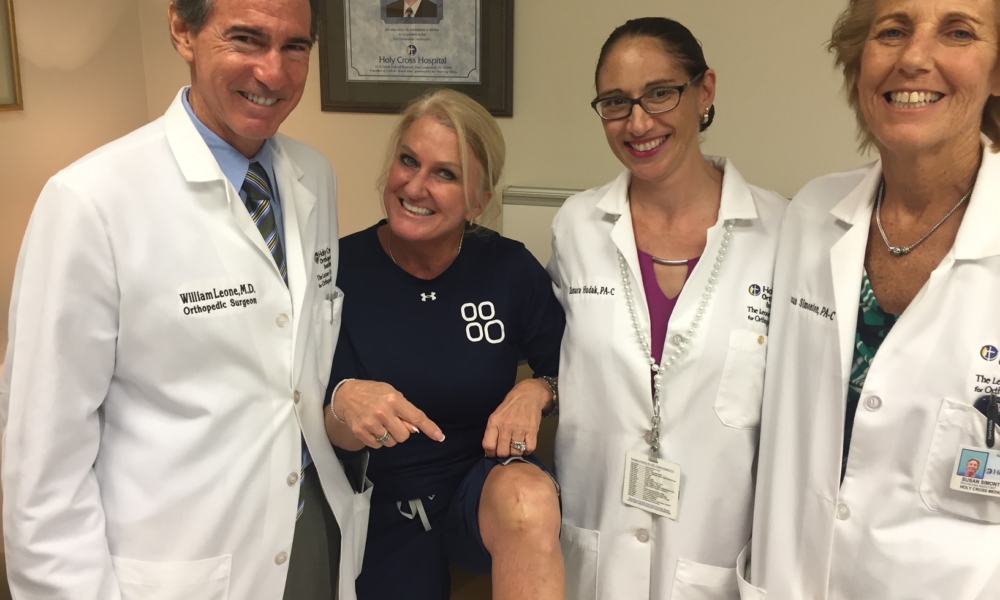
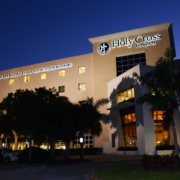
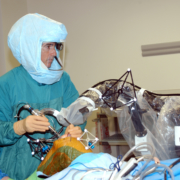


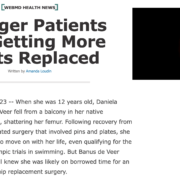
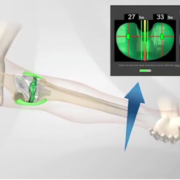





I am a 92 year old very healthy active lady with very painful arthritis of the left knee. My Doctor tells me he is willing to operate and replace my knee which will end the arthritis. I’m wondering if a partial knee replacement will also help with the arthritis. At this age, the full knee replacement recovery time and rehab might last as long as I do, hence if a partial will do it, I’d do that.
Very interesting explanation of the difference between full and partial knee replacement. I’m scheduled for a partial replacement of my left knee on June 30th this year. My surgeon is known locally as one of the very best in Maine having done thousands of these replacements. Your article help me understand the workings and difference between partial and full replacement. Thank you P.S. I’m 81 years old.
Dear Mr. Anctil,
Thank you for your kind words. I wish you a full and speedy recovery.
Sincerely,
Dr. William Leone
I would love to know your outcome as I am facing a partial replacement soon
I really appreciate all the information about knee replacement. I have really bowed legs and it has been getting harder and harder to get around without a lot of pain in my knees and legs. I wonder if I would benefit from a partial or full knee replacement. I will definitely look into seeing an orthopedic doctor. Thanks for the information!
Dear Alise,
Many patients who develop bow legs or genu varus deformity can be treated with partial knee replacement (PKR) rather than total knee replacement (TKR). Criteria have been developed to decide which procedure is appropriate. The specifics of the criteria are debated and they continue to evolve. In general, when deciding to perform PKR rather than TKR, these criteria include: a minimal bow leg or knock knee deformity, a correctable deformity (the deformity can be manually corrected), arthritis being limited to only one compartment (often some degree of patella femoral joint arthritis is ignored when considering medial uni-replacement if asymptomatic), minimal if any flexion contracture is present, and intact anterior and posterior cruciate ligaments that are functioning. A patient’s age and activity level all are part of the calculus.
I tell all of my patients that the final decision to proceed with PKR rather than TKR is made at the time of surgery. When an incision is made, I look carefully at all three compartments and if I see significant arthritis in one of the compartments I was not planning to replace, then a TKR will be done. Fortunately, this rarely occurs, but it is important that my patient understands this and my team is ready to change the plan if appropriate.
What is most important is the correct operation is chosen and then expertly performed. I would encourage you to be evaluated by an orthopedic surgeon.
I wish you well.
Dr. William Leone
We thank you for your readership. If you would like a personal consultation, please contact our office at 954-489-4584 or by email at LeoneCenter@Holy-cross.com. General comments will be answered in as timely a manner as possible.
I just turned 54 when I had partial knee replacement surgery. I’ve been a runner, triathlete and snow skier for over 40 years. I wore down the cartilidge in both knees but the right was much more painful. I’ve never had a weight problem so the obesity is not a factor here. I’m 5’10 and my average weight is 140 lbs. My surgery was Jan 20, 2016. It is now August 24th 2016 and I still have substantial stiffness in my knee. I did 5 months of Physical Therapy and have been working with a personal trainer and doing my own workouts. I finally just got back on my bike last week and rode 10 miles flat no hills and then 4 days later I rode 15 miles flat no hills. With every stroke of the pedal my knee was stiff. I do have full range of motion but constant stiffness and if I just push a little bit, my knee becomes swollen and sore. I ice now 1-2 times a day sometimes 3. I take Advil when it’s achey. I’m supposed to have the other knee done in October but because of my right knee still being so stiff, I’m reluctant. The only benefit I can see is that my deductible is fully met and it wouldn’t cost me anything. I want to be able to ski again and ride my bike long distances without the knee stiffness. I’m an extreme athlete and am not like your average 54 year old. I’m very frustrated at how long this knee is taking to heal. I was also told by my Dr that my replacement should last 25-30 years but the articles I’m reading here say 10-20, so which is it? The scar isn’t too bad but overall I have to say, I am not happy. ?
Dear Nancy,
Persistent pain, stiffness and swelling occurring more than eight months after partial knee replacement is concerning. While some people simply do take longer that others to get well, at this point I would discuss with your surgeon your concerns and look for his or her guidance. Sometimes it is also appropriate to seek second opinions.
Infection must always be considered and rule out. It also would be appropriate to compare serial X-rays, looking for component instability, as well as a critical assessment of component positioning and tracking. Swelling and stiffness can result from soft-tissue imbalance or residual problems (i.e., arthritis or a torn meniscus) in one of the two compartments which was not reconstructed. While a metal allergy has to be part of the differential, it is much less common than the other causes I mentioned and is very difficult to diagnose.
I would not suggest having your other knee reconstructed until you understand why you are still struggling with the first one.
I wish you a full recovery.
Dr. William Leone
We thank you for your readership. If you would like a personal consultation, please contact our office at 954-489-4584 or by email at LeoneCenter@Holy-cross.com. General comments will be answered in as timely a manner as possible.
A childhood injury 34 years ago has left both knees in need of replacing the right knee is the worst. The doctor refusing to do the surgery because he says I’m too young. The problem is the pain is interfering with my daily life I am very overweight and exercise is impossible because of my knee. Not sure what to do anymore. I thought total knee replacement was the answer but I just read about partial knee replacement. What do you think would benefit me.
Dear Valencia,
Knee replacement surgery very well may be in your future, in spite of your age. Prior to capitulating, it is important to show you’ve done everything you can to slow down progression and manage symptoms. Weight loss indeed can help on both of these fronts. I recognize being active and exercising becomes nearly impossible when you are miserable from an arthritic knee or hip. Some environments are more conducive than others, such as using a swimming pool. Approximately 90% of weight loss is diet, not exercise, and this is something in you control. Many people need help from a dietician or weight-loss support group.
At the end of the day, if you are miserable and disabled enough, then surgery may be the next reasonable step. The specific type of knee replacement, total versus partial, depends on the characteristics of your arthritis and exam. I would recommend that you discuss these concerns with your doctor. After you have fully explored and exhausted all conservative measures, if your current doctor is not comfortable doing your surgery then I would consider looking for other surgeons who are.
I wish you a full recovery.
Dr. William Leone
We thank you for your readership. If you would like a personal consultation, please contact our office at 954-489-4584 or by email at LeoneCenter@Holy-cross.com. General comments will be answered in as timely a manner as possible.
My grandma has some really bad knees, and we were thinking about looking into getting them fixed. It’s interesting that if you still have good range in your knee, you could qualify for partial replacement. Since she doesn’t really have that, they would probably do the whole knee.
thank you for your article Dr. Leone.
I just wrote my entire story and forgot to fill in below. I will try again.
I just had a partial knee replacement in Feb of 2016. My recovery and functionality has been severely compromised. I have gone back to my surgeon a few times complaining of pain. Not able to extend my knee while on my back… my knee wants to give out… excruciating pain when I’m at the gym trying to do basic things like a body weight squat or small step ups… I can’t do things like this and I don’t understand why. I have pain all around my knee, sometimes in the middle of my knee – on the outer side and back behind my knee, where your knee crease is/where you bend the knee. I like do weight training, but I can’t even do basic things with just my body weight because my knee hurts and wants to give out?
I thought the partial would be the answer to my prayers. My medial and lateral compartments look awesome, just have patella femoral chondromalacia. I thought in 6 months I would back in the gym doing gradual things and working my way back up to where I was. Though things have had to change in the gym, I think muscle tone is important and don’t want to completely give this up …
I sought a second opinion last week and the doc sees some subtle changes with the hemi-cap implant my surgeon used. There’s some translucency in 2 areas, though subtle, they are there. He also said based on all the xrays he has looked at, my knee is definitely not tracking right, kneecap is still pulling to the right (lateral side) a lot … (surgery was on my right knee)…
I’m 40 years old and the 2nd referral stated he wouldn’t go in and fix the implant or do another partial knee implant, the bone loss would be too severe because of the implant my surgeon used. He said he could go in and take the implant out, but going back in means a total knee replacement. He said there’s no guarantee with the total knee replacement, I could still have pain? I want to be out of pain, I want to play soccer with my kids and tennis, ride bikes and lift weights. Not lifting hardcore, but it’s part of my life and I would like to keep some light weight training if I can.
I’m so confused, scared and don’t know what to do. 2nd doc said no amount of physical therapy will change the outcome.. I won’t be out of pain because it’s loosened and not tracking.
Should I be completely scared of a TKR? Will I not be able to go back and do the things I want to? Should I just keep the partial and be in pain for 10-15 more years until I have probably have to do aTKR then?
Any advice, thoughts or opinions would be so great.
Thank you!
Mary W
Dear Mary,
The reason why your partial knee replacement (PKR) is causing these symptoms needs to be fully studied and understood. Infection must always be considered and ruled out, especially considering you have never done well post-operatively. If the patella is not tracking centrally now, was it also mal-tracking prior to your surgery? If so, can this problem be solved with a soft tissue operation to realign the extensor mechanism without revising the prosthesis? Is the femoral component loose? Is the patella component loose? Are they optimally sized? Sizing and implanting the femoral component can be difficult. Is there other pathology present in the knee which the PKR simply did not address? A MARS MRI may shed light on this. If a component instability problem (loosening) or mal-tracking problem is present, more exercise and time almost certainly will not cure these conditions.
If correctible problems are not identified and your work-up is consistent with pain being generated from your knee (not another source like your hip or back), then ultimately you may benefit from a TKR. You should proceed only if and when you feel disabled enough. Most people with partial or total knees who are pain free and stable are able to return to remarkably active lives.
I wish you full recovery.
Dr. William Leone
We thank you for your readership. If you would like a personal consultation, please contact our office at 954-489-4584 or by email at LeoneCenter@Holy-cross.com. General comments will be answered in as timely a manner as possible.
Dear Mary,
The reason why your partial knee replacement (PKR) is causing these symptoms needs to be fully studied and understood. Infection must always be considered and ruled out, especially considering you have never done well post-operatively. If the patella is not tracking centrally now, was it also mal-tracking prior to your surgery? If so, can this problem be solved with a soft tissue operation to realign the extensor mechanism without revising the prosthesis? Is the femoral component loose? Is the patella component loose? Are they optimally sized? Sizing and implanting the femoral component can be difficult. Is there other pathology present in the knee which the PKR simply did not address? A MARS MRI may shed light on this. If a component instability problem (loosening) or mal-tracking problem is present, more exercise and time almost certainly will not cure these conditions.
If correctible problems are not identified and your work-up is consistent with pain being generated from your knee (not another source like your hip or back), then ultimately you may benefit from a TKR. You should proceed only if and when you feel disabled enough. Most people with partial or total knees who are pain free and stable are able to return to remarkably active lives.
I wish you full recovery.
Dr. William Leone
We thank you for your readership. If you would like a personal consultation, please contact our office at 954-489-4584 or by email at LeoneCenter@Holy-cross.com. General comments will be answered in as timely a manner as possible.